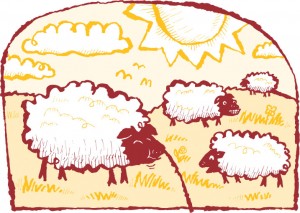Ari interviews The Telling Room author Michael Paterniti (part three)
Michael Paterniti’s book The Telling Room documents his pursuit of an obscure Spanish cheese – a cheese he first encountered while working at the Zingerman’s Deli back in 1991.
On Thursday, September 26, 6:30pm, Mike will visit the Deli and tell the story himself. He’ll sign copies of the book, as well as copies of the Zingerman’s newsletter that features the book’s release. We’ll also taste a delicious selection of fine Spanish foods, including many of our favorite traditional cheeses. Copies of Michael’s new book are available at fine bookstores everywhere, but seats at the event are limited. Reserve a seat online or call 734-663-3400!
You’ve created a great non-profit in Portland Maine called the Telling Room. Can you share with folks what it’s about?
Thanks so much for asking! We’re coming up on our tenth anniversary, and it’s just been amazing to be a part of this organization that has about 200 volunteers, and serves roughly 2,500 kids a year. Among other things, we offer writing and storytelling workshops, in all genres and media. And we work with wonderfully diverse storytellers, who constantly blow our minds. When my wife and I came back from living in Spain in 2003, we decided we wanted to try to make a telling room in Portland, to mimic Ambrosio’s in Guzmán, a space where people could tell their stories and secrets and dreams. That’s where we began, and today it’s grown into this wonderful nexus in our community. And I’m always awed and inspired by how courageous the kids are, what natural storytellers we all are if given some guidance and an audience. We’re at www.tellingroom.org, for anyone who might want to know more. I can say, though, that it’s been one of the best things in my life.
Talking about storytelling and sharing tradition, Gary Snyder, the Beat poet, wrote that “Books are our grandparents.” It struck me that, in the same way Ambrosio was hoping each successive batch of cheese would “remember” him and his family, that the books we write them are as much our children as they are “our grandparents” later when we read them. You worked to give birth to this book for a long time. Is it like a child?
I’m gonna go with that! I haven’t given birth myself, but man, at times it felt as if I was. I think of books as having a birthing process but maybe emerging as grandparents. Does that work?
Ambrosio says at one point, “When you put love and care and hundreds of years of history into a product like this one, you can taste all of it.” He goes on to say, “. . . if you asked me the secret, I’d say it was because we made it in our home, the old way, the way it had been made for hundreds of years. Perhaps in the United States you don’t know what it’s like to have old flavors, flavors from the past, from centuries before. But we lived with them every day here. My children know those flavors.” And then he finishes the point: “My mission is to make sure we don’t forget the old way.” It’s a great bit of the book for me. It makes me realize why I was so drawn to Páramo de Guzmán cheese back in the early ‘90s. He’s really summed up what we believe at Zingerman’s and about our pursuit of traditional food and flavor. Thoughts?
I think it’s absolutely no coincidence that I found this cheese here at Zingerman’s. I’m not sure many, if anyone else, in the country was selling Páramo de Guzmán at the time. You and Ambrosio are simpatico brothers, for sure.
You write about Ambrosio’s tale as being “the kind of fable in which everything, especially the hero, is bigger than life and thus takes on the quality of legend.” I think that kind of sums up the spirit of the whole story. Is Ambrosio a man of almost mythical proportion?
For years, he was exactly that to me. And in order to finish the book, my greatest struggle was forcing myself to try to see him as a man, a person with flaws like all of us, but who as you say had this “mythical proportion,” and life philosophy, that I really needed to believe in.
You write that Páramo de Guzmán “was a visionary’s cheese: It cut to the heart of how (Ambrosio) felt a human being should eat.” It’s funny that twenty years later, here we are at Zingerman’s teaching visioning to the rest of the world, and this cheese that resonated with you and with me so long ago was very much a cheese that fits with that model. What makes you say it was a visionary’s cheese?
Because it was an impossible cheese, too. It took some years to recover the recipe because it wasn’t written down. And it was hard to make. It relied on local sheep, Churra sheep, that produce less milk. And the milk was then rushed a quarter mile from the barn to the stable where they first made the cheese. And the curd of the cheese was cut quite small, which was time-consuming and made it very dense. Ambrosio would take the cheese up to the cave for aging, but then he’d show up every day, to turn the wheels, too. The process of making the cheese required care and attention, from the be- ginning to the end. And as Ambrosio said, this process of pouring your love and care into something was also what you tasted when you tasted Páramo de Guzmán. It was the classic case of one person, rebelling, looking at a culture fattened on industrialized food, on cheese products spelled C-H-E-E-Z (Cheez Whiz, Cheez Doodles) and asking, Why can’t we make it like this, by hand, the old way? I think people tasted that in the cheese—and fell in love with it, too.
What’s it been like to come back to Zingerman’s twenty years later?
Fantastic—and a bit of a mind-bend! I mean, look at this place. The Roadhouse. The Creamery. All the things you have going on. It feels as if that original seed, planted all those years ago, spurred an American movement that coincided with these bigger ideas about food that we now hold more commonplace. We want to know where our food comes from, and what the stories are. Talk about visionary: You guys really were here at the beginning, preaching all of this before it was fashionable!
When all else is said and done, what would you like people to know about the book?
In reading it, I’d love for them to feel that sense of awe I have every time I go back to Guzmán, and spend time in Ambrosio’s presence because he’s such an immense, compelling character. I’d love for people to feel they’ve escaped the digital speed of our lives for a little bit, and been transported to a pretty magical place that exists up there on those Castilian highlands. I would hope that they might be embraced inside this story the way I was—as if sitting in a real telling room, listening to Ambrosio—and then feel the trapdoors open, until they’re lost in this otherworld where nothing really is exactly as it seems, where some of the deeper pains of life are alleviated by the pleasure of the stories that get told.
See you at the event!




Zingerman’s Art for Sale